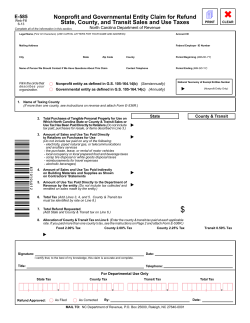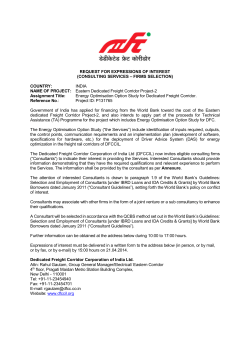
NCHRP Project 20-102 Impacts of Connected Vehicles and
NCHRP Project 20-102 Impacts of Connected Vehicles and Automated Vehicles on State and Local Transportation Agencies Announcement of New Tasks, January 2015 The National Cooperative Highway Research Program (NCHRP) is supported on a continuing basis by funds from participating member departments of the American Association of State Highway and Transportation Officials (AASHTO), with the cooperation and support of the Federal Highway Administration, U.S. Department of Transportation. The NCHRP is administered by the National Research Council’s Transportation Research Board (TRB). The NCHRP is an applied contract research program totally committed to providing timely solutions to operational problems facing highway and transportation practitioners and administrators. The objectives of NCHRP Project 20-102 are to (1) identify critical issues associated with connected vehicles and automated vehicles that state and local transportation agencies and AASHTO will face, (2) conduct research to address those issues, and (3) conduct related technology transfer and information exchange activities. This announcement contains preliminary descriptions of those tasks that will be undertaken in the first year of NCHRP Project 20-102. Nominations for panel members to oversee each of these tasks are currently being sought. A nomination form and résumé should be sent to Ms. Adrienne Blackwell (ablackwell@nas.edu) by February 17, 2015. You may nominate yourself or others. Panel members will be responsible for (1) developing the final scope of work, (2) selecting the best contractor, (3) overseeing the contractor’s work, and (4) reviewing and recommending publication of interim and final deliverables. The tasks included in this announcement are drawn from a research roadmap developed through NCHRP Project 20-24(98). That roadmap is available on the project webpage and describes a five-year, $15M effort addressing the policy, planning, and implementation issues that will face state and local transportation agencies. This roadmap will be continually reviewed and modified based on events in the public and private sectors. The research described exceeds the resources that are expected to be available through the NCHRP and it is hoped that other organizations will choose to undertake some of the described efforts. Statements of qualifications have been received from those interested in serving as task-order contractors for NCHRP Project 20-102. For each task, proposals will be requested from the selected task-order contractors. Unsolicited proposals from other organizations will not be considered. Address inquiries to: B. Ray Derr Project Manager National Cooperative Highway Research Program Transportation Research Board rderr@nas.edu SUMMARY OF APPROVED RESEARCH PROJECTS ♦ Project 20-102(01) Identification of State and Local Policy and Planning Actions That Could Facilitate Implementation of CV and AV Systems Allocation: $400,000 Source: NCHRP 20-24(98) Research Roadmap, Task Statement 1.3 Staff: B. Ray Derr Research Problem Statement: Connected and automated vehicle systems are likely to have societal benefits that are not captured in market decision making about acquiring and operating systems based on private cost-effectiveness considerations. State and local governments need to know what policy and planning actions they can take to stimulate the development of markets for CV and AV systems so that the societal externalities can be internalized in market decisions. Task Outline: This project should follow a basic flow from identification of impediments to marketbased deployment of CV and AV systems to identification of possible policy and planning actions to overcome those impediments to prioritization of policy and planning actions based on their expected impact and feasibility: (1) Identify the mismatches between societal benefits and individual private actor benefits from implementation of CV and AV systems, based on the project team’s knowledge of the literature on CV and AV systems and interviews with key experts and stakeholders. (2) Identify a broad range of policy and planning actions that state and/or local agencies could use to better align the interests of private actors (individuals and corporations on both the supplier and user sides of the markets) with the broader public interest in achieving benefits in traffic safety, traffic congestion reduction, and savings in energy and criteria pollutant emissions. These are expected to include actions such as: Preferential access to HOV/HOT lanes (including reduced toll rates) Tax and other financial incentives (waiving taxes on incremental costs for AV systems or subsidizing their purchase) Providing connected vehicle communication infrastructure Improving road markings and signage Developing or facilitating technology incubators or testing facilities Encouraging new forms of publicprivate partnerships Sponsoring pilot testing or deployment programs Acquiring AVs for state fleet operations Changing laws regarding direct vehicle sales by manufacturers versus sales only by dealers. (3) Assess each of the suggested policy and planning actions for cost, political feasibility and likely impact on market decisions that could accelerate deployment of CV and AV systems. Deliverables: Report with recommended policy and planning actions and estimates of their expected costs and impacts on deployment of both CV and AV systems. ♦ Project 20-102(02) Impacts of Transit System Regulations and Policies on CV/AV Technology Introduction Allocation: $150,000 Source: NCHRP 20-24(98) Research Roadmap, Task Statement 4.1 Staff: William C. Rogers Research Problem Statement: CV/AV technologies offer potential benefits to improve safety and increase efficiency of transit systems for owners and operators. Closed, fixed-guideway transit systems could be re-imagined as lower cost services with rubber-tire vehicles that operate with less infrastructure protection. In addition, AV systems will impact transit services in qualitative ways. First- and last-mile AV services to bring riders to line-haul modes could significantly increase ridership. Dynamic taxi-like services could improve coverage of transit service to rural and suburban areas, however, relatively few state DOTs have significant involvement or influence over transit systems and there are many issues associated with transit operations that DOT and local agency staff need to better understand as CV/AV applications emerge. For example, extensive regulations and rules govern the operating parameters and characteristics of transit systems, some of which may be incompatible with CV and/or AV technologies, such as provisions to avoid elimination of current jobs regardless of the potential to create new jobs. The role of the driver will need to change, which will require significant coordination with labor unions. New procedures for certification of the safety of automated transit systems that are not confined to fixed guideways may be needed and insurance models for transit operators may need adjustment. These issues need to be better understood and next steps identified to enable widespread adoption of CV/AV technologies in transit systems. Task Outline: The research team will develop a primer on the regulatory and policy landscape of transit system planning, development, funding, and operations and identify the pain points or areas where any policy changes are necessary to accommodate (or facilitate) deployment of different types of CV/AV technologies. In particular, this project should explore how the existing procedures for certifying and testing fixed-guideway transit systems can be modified to apply to CV and AV systems that are not confined to fixed guideways. The team will then develop and deliver a set of recommendations and a plan of future work for adjusting the current regulatory and policy landscape of transit safety regulation. Deliverables: Phase I: Report on existing transit regulatory/policy/operational environments and challenges for CV/AV technologies Phase II: Recommendations and plan of action for addressing the challenges ♦ Project 20-102(03) Critical Next Steps for AV/CV Applications in Freight Operations Allocation: $150,000 Source: NCHRP 20-24(98) Research Roadmap, Task Statement 4.2 Staff: William C. Rogers Research Problem Statement: CV/AV technologies offer potential benefits to improve safety and increase efficiency of freight and goods movement in North America. The freight industry is extremely important to the economic vitality of our nation. Trucking is a strong component of this, as over 70% of all freight is carried by truck at some stage in the supply chain. The trucking industry faces critical challenges in maintaining adequate workforce. AV/CV technologies could be useful to fill in the unmet needs with automated resources, raise the status of a career in trucking, and reduce the workload of the driver in long-haul (and other) operations. Truck parking and rest areas are often strategically located to align with hours-ofservice limitations. If hours-of-service were modified due to AV systems, national planning for rest areas and en-route facilities could be modified. Truck platooning is commonly identified as a near term application, but to make that a reality a variety of platooning protocols and procedures need to be defined and verified. Automated drayage and automated docking are frequently noted as highly desirable by the trucking industry. The regulatory, policy, and technical aspects of AV technologies on the trucking and freight operations industry need to be evaluated and recommendations developed for state DOT and local agencies that are involved with freight operations. Task Outline: The research team will review existing literature and develop a list of key issues and challenges in the regulatory, policy, and operations landscape of freight system operations and identify the pain points or areas where policy and operations strategy changes are necessary to accommodate (or facilitate) CV/AV deployment. In particular, truck platooning concepts should be explored and a list of near-term actions should be developed to answer the key research and policy questions. Deliverables: Phase I: Report on existing freight regulatory/policy/operational environments and challenges for CV/AV technologies Phase II: Recommendations and plan of action for addressing the challenges
© Copyright 2025
















